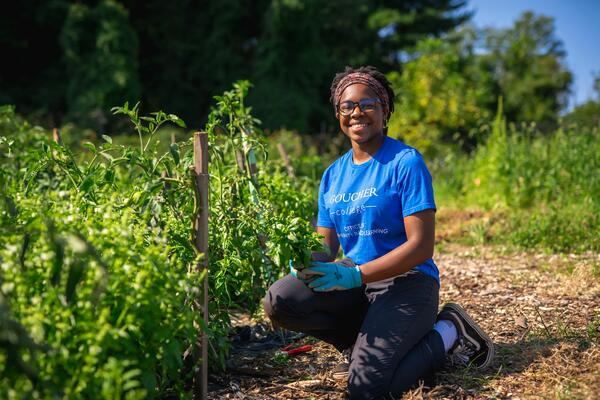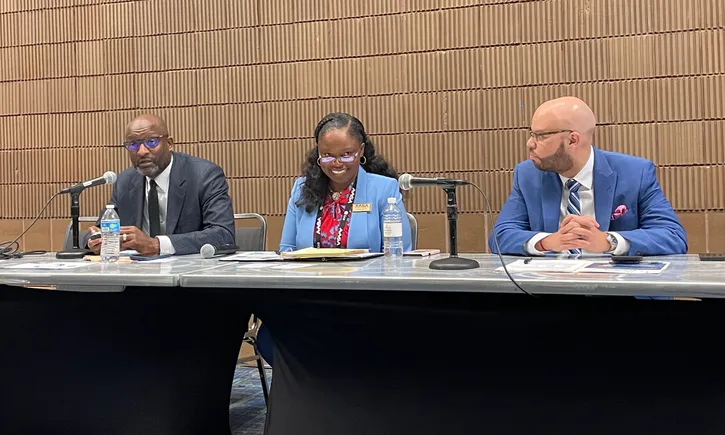The economy is uncertain, but eight in 10 undergraduates somewhat or strongly agree that their college is preparing them with the skills, credentials and experiences they need to succeed in today’s job market. At the same time, most students are stressed about the future. Their biggest stressors vary but include not being to afford life after graduation, not having enough internship or work experience to get a job, and feeling a general pressure to succeed. That’s all according to new data from Inside Higher Ed’s annual Student Voice survey of more than 5,000 two- and four-year students with Generation Lab.
What can colleges do to help? The No. 1 thing Student Voice respondents want their institution to prioritize when it comes to career readiness is help finding and accessing paid internships. No. 2 is building stronger connections with potential employers. Colleges and universities could also help students better understand outcomes for past graduates of their programs: Just 14 percent of students say their college or university makes this kind of information readily available.
About the Survey
Student Voice is an ongoing survey and reporting series. Our 2025–26 cycle, Student Voice: Amplified, gauged students’ thoughts on trust, artificial intelligence, academics, cost of attendance, campus climate, health and wellness, and campus involvement.
Some 5,065 students from 260 two- and four-year institutions, public and private nonprofit, responded to this main annual survey about student success, conducted in August. Explore the data captured by our survey partner Generation Lab here and here. The margin of error is plus or minus one percentage point.
Shawn VanDerziel, president and CEO of the National Association of Colleges and Employers (NACE), said there’s “no doubt that the college experience equips students with a lifelong foundation for the general job market,” so it’s “heartening to hear” they have confidence that their academic programs are setting them up to succeed.
The challenge, however, “often becomes putting that learning and experience into the job market context—translating and articulating the experience that is meaningful to employers,” he added.
Beyond helping students frame what they’ve learned as competencies they can clearly communicate to prospective employers (who are increasingly interested in skills-based hiring), colleges also need to scale experiential learning opportunities. NACE has found that paid internships, in particular, give students a measurable advantage on the job market, and that Gen Z graduates who took part in internships or other experiential learning opportunities had a more favorable view of their college experience than those who didn’t. These graduates also describe their degree as more relevant to their eventual job than peers who didn’t participate in experiential learning.
While paid internships remain the gold standard for experience, student demand for them vastly outstrips supply: According to one 2024 study, for every high-quality internship available, more than three students are seeking one. Other students can’t afford to leave the jobs that fund their educations in order to take a temporary internship, paid or unpaid; still others have caring or other responsibilities that preclude this kind of experience. VanDerziel said all of this is why some institutions are prioritizing more work-based learning opportunities—including those embedded in the classroom.
Many institutions are “working toward giving more of their students access to experiential learning and skill-building activities—providing stipends for unpaid experiential experiences and ensuring that work-study jobs incorporate career-readiness skills, for example,” he said. “There is positive movement.”
One note of caution: Colleges adding these experiences must ensure that they have “concrete skill-building and job-aligned responsibilities in order to maximize the benefits of them for the students,” VanDerziel added.
Here are the career readiness findings from the annual Student Voice survey, in five charts—plus more on the experience gap.
- Program outcomes data is unclear to students.
Across institution types and student demographics, a fraction of respondents (12 percent over all) say they know detailed outcomes data for their program of study. A plurality of students say they know some general information. Just 14 percent indicate this information is readily available.
outcomes-1h0n25opyx3xz4p
View online
- Students remain lukewarm on career services.
Similar to last year’s survey, students are more likely to describe career services at their institution as welcoming (31 percent) than effective (17 percent), knowledgeable about specific industries and job markets (15 percent), or forward-thinking (9 percent). Career centers across higher education are understaffed, which is part of the reason there’s a push to embed career-readiness initiatives into the curriculum. But those efforts may not be made plain enough, or come across as useful, to students: Just 8 percent of respondents this year indicate that career services are embedded in the curriculum at their institution. Double that, 16 percent, say that career services should be more embedded in the curriculum. Three in 10 indicate they haven’t interacted with career services, about the same as last year’s 30 percent.
- Students still want more direct help finding work-based learning opportunities.
Also similar to last year, the top thing students want their institution to prioritize regarding career readiness is help finding and accessing paid internships. That’s followed by stronger connections with potential employers and courses that focus on job-relevant skills. A few differences emerge across the sample, however: Adult learners 25 and older are less likely to prioritize help finding internships (just 26 percent cite this as a top need versus 41 percent of those 18 to 24); their top want is stronger connections with potential employers. Two-year college students are also less likely to prioritize help finding internships than are their four-year peers (30 percent versus 41 percent).
- Most students are worried about life after college, but specific stressors vary.
Just 11 percent of students say they’re not stressed about life postgraduation, though this increases to 22 percent for students 25 and older and to 17 percent among community college students. Top stressors vary, but a slight plurality of students (19 percent) are most concerned about affording life after college. Adult learners and community college students are less likely than their respective traditional-age and four-year counterparts to worry about not having enough internship or work experience.
- Despite their anxiety, students have an underlying sense of preparation for what’s ahead.
Some 81 percent of all students agree, strongly or somewhat, that college is preparing them with the skills, credentials and experiences they need to succeed in today’s job market. This is relatively consistent across institution types and student groups, but the share decreases to 74 percent among students who have ever seriously considered stopping out of college (n=1,204).
The Widening Experience Gap
Students increasingly need all the help they can get preparing for the workforce. For the first time since 2021, the plurality of employers who contributed to NACE’s annual job outlook rated the hiring market “fair,” versus good or very good, on a five-point scale. Employers are projecting a 1.6 percent increase in hiring for the Class of 2026 when compared to the Class of 2025, comparable to the tight labor market employers reported at the end of the 2024–25 recruiting year, according to NACE.
Economic uncertainty is one factor. Artificial intelligence is another. VanDerziel said there isn’t meaningful evidence to date that early-talent, professional-level jobs are being replaced by AI, and that even adoption of AI as a tool to augment work remains slow. Yet the picture is still emerging. One August study found a 13 percent relative employment decline for young workers in the most AI-exposed occupations, such as software development and customer support. In NACE’s 2026 Job Outlook, employers focused on early-career hiring also reported that 13 percent of available entry-level jobs now require AI skills.
The August study, called “Canaries in the Coal Mine? Six Facts about the Recent Employment Effects of Artificial Intelligence,” frames experience as a differentiator in an AI-impacted job market. In this sense, AI may be widening what’s referred to as the experience gap, or when early-career candidates’ and employers’ expectations don’t align—a kind of catch-22 in which lack of experience can limit one from getting the entry-level job that would afford them such experience.
Ndeye Sarr, a 23-year-old engineering student at Perimeter College at Georgia State University who wants to study civil and environmental engineering at a four-year institution next fall, believes that her studies so far are setting her up for success. Earlier this year, she and several Perimeter peers made up one of just 12 teams in the country invited to the Community College Innovation Challenge Innovation Boot Camp, where they presented RoyaNest, the low-cost medical cooling device they designed to help babies born with birth asphyxia in low-resource areas. The team pitched the project to a panel of industry professionals and won second-place honors. They also recently initiated the patenting process for the device.

Ndeye Sarr
“This has helped me have a bigger vision of all the problems that are happening in the world that I might be able to help with when it comes to medical devices and things like that,” Sarr said, adding that faculty mentorship played a big role in the team’s success. “I think that’s what we’re most grateful for. Perimeter College is a pretty small college, so you get to be in direct contact with most of your mentors, your professors, which is very rare in most settings. We always get the support we need it anytime we’re working on something, which is pretty great.”
RoyaNest was born out of a class assignment requiring students to design something that did not require electricity. Sarr said she wishes most courses would require such hands-on learning, since it makes class content immediately relevant and has already helped put her in touch with the broader world of engineering in meaningful ways. This view echoes another set of findings from the main 2025 Student Voice survey: The top two things students say would boost their immediate academic success are fewer high-stakes exams and more relevant course content. And, of course, there are implications for the experience gap.
Sometimes you can even be in your senior year, and you will be like, ‘I don’t think I have all these skills!’ Even for an entry-level job, right?”
—Student Ndeye Sarr
“Mostly it’s like you go to class, and they will give you a lecture because you have to learn, and then you go do a test,” Sarr said of college so far. “But my thinking is that you can also do those hands-on experiences in the classroom that you might have to do once we start getting into jobs. Because when you look at the job descriptions, they expect you to do a lot of things. Sometimes you can even be in your senior year, and you will be like, ‘I don’t think I have all these skills!’ Even for an entry-level job, right?”
This challenge also has implications for pedagogy, which is already under pressure to evolve—in part due to the rise of generative AI. Student success administrators surveyed earlier this year by Inside Higher Ed with Hanover Research described a gap between the extent to which high-impact teaching practices—such as those endorsed by the American Association of Colleges and Universities—are highly encouraged at their institution and widely adopted (65 percent versus 36 percent, respectively). And while 87 percent of administrators agreed that students graduate from their institution ready to succeed in today’s job market, half (51 percent) said their college or university should focus more on helping students find paid internships and other experiential learning opportunities.
In addition to the national innovation challenge, Sarr attended the Society of Women Engineers’ annual conference this year, where she said the interviewing and other skills she’s learned from Perimeter’s career services proved helpful. Still, Sarr said she—like most Student Voice respondents—worries about life postgraduation. Top concerns for her are financial in nature. She also feels a related pressure to succeed. Originally from Senegal, she said her family and friends back home have high expectations for her.
“You pay a lot of money to go to college, so imagine you graduate and then there’s no way you can find a job. It’s very stressful, and I am from a country where everybody’s like, ‘OK, we expect her to do good,’” Sarr said. But the immediate challenge is paying four-year college expenses starting next year, and financing graduate school after that.
“I want to go as far as I can when it comes to my education. I really value it, so that’s something I am very scared about,” she said. “There’s a lot of possibilities. There are scholarships, but it’s not like everybody can get them.”
VanDerziel of NACE said that, ultimately, “Today’s labor market is tough, and students know it. So it doesn’t surprise me that they are feeling anxiety about obtaining a job that will allow them to afford their postgraduation life. Many students have to pay back loans, are uncertain of the job market they are going to be graduating into and are concerned about whether their salary will be enough.”










